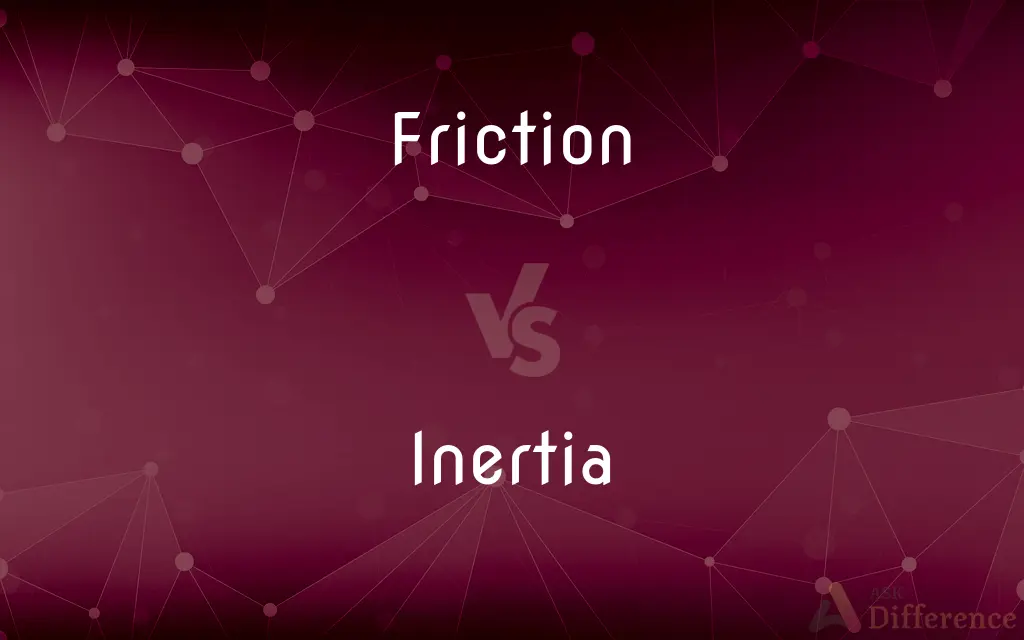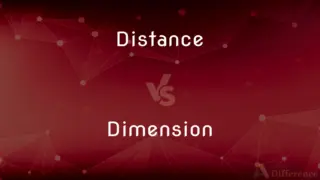Friction vs. Inertia — What's the Difference?
By Urooj Arif & Maham Liaqat — Updated on March 12, 2024
Friction is the resistance encountered when two surfaces move over each other, while inertia is the tendency of an object to resist changes in its state of motion.

Difference Between Friction and Inertia
Table of Contents
ADVERTISEMENT
Key Differences
Friction is a force that occurs when two surfaces interact, opposing the motion of one surface across the other and is dependent on the nature of the surfaces and the force pressing them together. It plays a crucial role in everyday activities, providing the grip needed for walking and driving. On the other hand, inertia is a property of matter that makes an object resist changes to its velocity, whether it is at rest or moving. It's the reason why an object remains at rest or continues to move at a constant velocity unless acted upon by an external force.
The effects of friction are most apparent when attempting to move or stop objects. It acts in the opposite direction of motion, slowing down or stopping moving objects and making it difficult to start moving objects at rest. Whereas inertia is observed when an external force is applied to an object. For example, when a car suddenly stops, passengers experience a forward jolt due to their inertia; their bodies tend to continue moving forward even though the car has stopped.
Friction can be categorized into several types, such as static, kinetic, and rolling friction, each playing a different role in the interaction between surfaces. Static friction prevents surfaces from sliding past each other and must be overcome to start motion. Kinetic friction occurs when objects are already in motion, and rolling friction applies to objects like wheels or ball bearings. In contrast, inertia is a singular concept in physics, described by Newton's first law of motion, and does not have subcategories. It applies universally to all objects with mass.
The magnitude of friction between two surfaces can be altered by changing the nature of the surfaces or the force pressing them together. For example, lubrication can reduce friction by providing a smoother interface between surfaces. Inertia, however, is solely dependent on the mass of an object. The greater the mass, the greater the inertia, and this property cannot be changed by altering surface characteristics or external forces, except by changing the object's mass.
In practical applications, friction is both beneficial and detrimental. It is essential for many mechanical processes, providing the necessary resistance for motion, but it also leads to wear and energy loss. Inertia, while not a force, is a fundamental principle that must be considered in the design of transportation systems, machinery, and safety measures, ensuring that objects behave predictably when forces are applied.
ADVERTISEMENT
Comparison Chart
Definition
Resistance force encountered when two surfaces move over each other.
Property of an object that resists changes to its state of motion.
Dependence
Nature of surfaces, force pressing them together.
Mass of the object.
Types
Static, kinetic, rolling.
No types; a universal property of matter.
Effects
Opposes motion, necessary for grip and control.
Causes objects to maintain their state of motion or rest.
Variability
Can be altered with lubrication, surface treatment.
Invariant, depends only on mass.
Compare with Definitions
Friction
Resistance Force
Friction between the shoe and the floor prevents slipping.
Inertia
Resistance to Change
A parked car requires force to overcome inertia and start moving.
Friction
Can be Reduced
Oil reduces friction between machine parts, allowing smoother movement.
Inertia
Mass Dependent
A heavier object has more inertia, making it harder to push.
Friction
Dual Nature
While necessary for movement, excessive friction causes wear and energy loss.
Inertia
Universal Property
Everything with mass exhibits inertia, from atoms to planets.
Friction
Dependent on Surfaces
Sandpaper has high friction due to its rough surface.
Inertia
Safety Considerations
Seatbelts counteract inertia, keeping passengers in place during sudden stops.
Friction
Types and Roles
Rolling friction allows wheels to roll effectively, reducing sliding friction.
Inertia
Constant in Motion
An object in space continues to move indefinitely due to inertia in the absence of friction.
Friction
Friction is the force resisting the relative motion of solid surfaces, fluid layers, and material elements sliding against each other. There are several types of friction: Dry friction is a force that opposes the relative lateral motion of two solid surfaces in contact.
Inertia
Inertia is the resistance of any physical object to any change in its velocity. This includes changes to the object's speed, or direction of motion.
Friction
The resistance that one surface or object encounters when moving over another
A lubrication system which reduces friction
Inertia
A tendency to do nothing or to remain unchanged
The bureaucratic inertia of the various tiers of government
Friction
The rubbing of one object or surface against another.
Inertia
A property of matter by which it continues in its existing state of rest or uniform motion in a straight line, unless that state is changed by an external force
The power required to overcome friction and the inertia of the moving parts
Friction
Conflict, as between persons having dissimilar ideas or interests; clash.
Inertia
(Physics) The tendency of a body at rest to remain at rest or of a body in straight line motion to stay in motion in a straight line unless acted on by an outside force; the resistance of a body to changes in momentum.
Friction
(Physics) A force that resists the relative motion or tendency to such motion of two bodies or substances in contact.
Inertia
Resistance or disinclination to motion, action, or change
An entrenched bureaucracy's inertia.
Friction
The rubbing of one object or surface against another.
Inertia
The property of a body that resists any change to its uniform motion; equivalent to its mass.
Friction
(physics) A force that resists the relative motion or tendency to such motion of two bodies in contact.
Inertia
(figuratively) In a person, unwillingness to take action.
Friction
Massage of the body to restore circulation.
Inertia
(medicine) Lack of activity; sluggishness; said especially of the uterus, when, in labour, its contractions have nearly or wholly ceased.
Friction
(figuratively) Conflict, as between persons having dissimilar ideas or interests; clash.
Inertia
That property of matter by which it tends when at rest to remain so, and when in motion to continue in motion, and in the same straight line or direction, unless acted on by some external force; - sometimes called vis inertiæ. The inertia of a body is proportional to its mass.
Friction
(Second Sino-Japanese War) Conflict, as between the Communists and non-Hanjian Kuomintang forces.
Inertia
Inertness; indisposition to motion, exertion, or action; lack of energy; sluggishness.
Men . . . have immense irresolution and inertia.
Friction
The act of rubbing the surface of one body against that of another; attrition; in hygiene, the act of rubbing the body with the hand, with flannel, or with a brush etc., to excite the skin to healthy action.
Inertia
Lack of activity; sluggishness; - said especially of the uterus, when, in labor, its contractions have nearly or wholly ceased.
Friction
The resistance which a body meets with from the surface on which it moves. It may be resistance to sliding motion, or to rolling motion.
Inertia
A disposition to remain inactive or inert;
He had to overcome his inertia and get back to work
Friction
A clashing between two persons or parties in opinions or work; a disagreement tending to prevent or retard progress.
Inertia
(physics) the tendency of a body to maintain is state of rest or uniform motion unless acted upon by an external force
Friction
A state of conflict between persons
Friction
The resistance encountered when one body is moved in contact with another
Friction
Effort expended in rubbing one object against another
Common Curiosities
What is friction?
Friction is the resistance force that arises when two surfaces move over or attempt to move over each other.
Why is rolling friction important for vehicles?
Rolling friction, which occurs in wheels, is lower than sliding friction, making it easier for vehicles to move and reducing energy loss.
What role does friction play in sports?
Friction is crucial in sports for providing traction and control, such as between athletic shoes and the ground or between a ball and the surfaces it contacts.
How does inertia work?
Inertia is the tendency of an object to resist changes in its motion, either staying at rest or moving at a constant velocity until acted upon by an external force.
Is inertia the same for all objects?
While all objects with mass exhibit inertia, the amount of inertia an object has depends on its mass. More massive objects have greater inertia.
How is inertia related to Newton's first law of motion?
Inertia is the principle behind Newton's first law, which states that an object will remain at rest or in uniform motion in a straight line unless acted upon by an external force.
Can inertia be observed in space?
Yes, inertia is especially noticeable in space, where objects continue moving in a straight line at constant speeds due to the lack of friction.
Can friction be eliminated completely?
While friction can be significantly reduced through lubrication or special surface treatments, it cannot be entirely eliminated due to the fundamental interactions between surface molecules.
How do friction and inertia affect driving?
In driving, friction between the tires and road surface provides the grip necessary for motion and control, whereas inertia affects the vehicle's response to acceleration and deceleration.
Can the direction of friction ever aid in motion?
While friction typically opposes motion, it is essential for initiating movement, such as when walking, where friction between the foot and ground propels you forward.
How do friction and inertia interact during a car crash?
In a crash, friction between the car and road or obstacles reduces the car's speed, while inertia causes occupants to continue moving forward, highlighting the need for safety restraints.
Why is understanding inertia important for safety in vehicles?
Understanding inertia is crucial for designing safety features like seatbelts and airbags that protect passengers by counteracting the effects of inertia during sudden stops or collisions.
How does mass affect inertia?
The greater the mass of an object, the greater its inertia. This means heavier objects are more resistant to changes in their motion.
What are some examples of reducing friction in everyday life?
Examples include oiling door hinges, using wax on snowboards, and air cushioning in hovercrafts to reduce friction and facilitate smoother motion.
What advancements have been made to control friction in mechanical systems?
Advancements include the development of synthetic lubricants, surface coating technologies, and materials like graphene, which offer superior lubrication and wear resistance.
Share Your Discovery

Previous Comparison
Distance vs. Dimension
Next Comparison
Delay vs. TardyAuthor Spotlight
Written by
Urooj ArifUrooj is a skilled content writer at Ask Difference, known for her exceptional ability to simplify complex topics into engaging and informative content. With a passion for research and a flair for clear, concise writing, she consistently delivers articles that resonate with our diverse audience.
Co-written by
Maham Liaqat













































